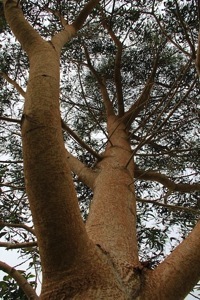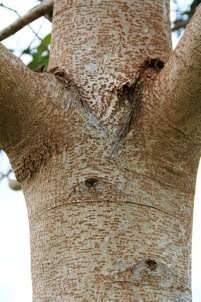Hawaii’s Forests

The Big Island of Hawaii is home to 11 of the world's 13 climate zones. The 11 climate zones of Hawaii range from tropical rainforests, volcanic deserts, cool uplands, to peri-glacial Arctic climates at the tops of Mauna Kea and Mauna Loa (each almost 14,000 feet tall).
From rainforest to the snowy top of Mauna Kea, this photo is a great example of the many climate zones on the Big Island of Hawaii
Tropical Hawaiian rainforests exist on the four main islands of Hawaii, comprising a total of around 2600 square miles.
You can think of a native Hawaii rainforest as consisting of 3 layers. The top canopy is dominated by ohia lehua and acacia koa. The middle layer consists of a variety of smaller trees and shrubs. The bottom layer consists mostly of ferns (e.g. hapuu) and berries.
Hawaii's rain forests have been in decline ever since the arrival of Captain Cook in the late 1700's. Much of the native Hawaiian sandalwood was harvested in the early 1800's to feed a relentless demand for this fragrant wood from China. More devastating by far, though, was the introduction of cattle to the native Hawaiian forests. Though cattle do not destroy larger trees, they continually eat young trees as they germinate. Thus, over time, cattle ranching in wooded areas causes the decimation of the forests. No new trees can get a start, and eventually the older trees fall down and die. The result is large areas of upland pasture where there used to be mature native Hawaiian forests.
Hawaii's rain forests are not just important for their wood and plant resources. They are essential to a healthy watershed. Rain and forests have a symbiotic relationship embodied in the Hawaiian saying hahai no ka ua i ka ulula'au, which translates as "The Rain Follows the Forest". Without forests acting as a big sponge on higher elevations, rain water runs off quickly and more forcefully, causing erosion and carrying soil into the ocean. The land loses soil and water. The coral reefs suffer due to the dirt in the water that covers and suffocates the polyps.
This is exactly the situation around Ahu Lani Sanctuary. Ahu Lani is surrounded by cattle ranches and pastures. Kalopa Stream, which we border, used to run full time according to older people in the neighborhood. Now it only runs after heavy rains. The reason is because the upland forests have disappeared due to cattle ranching.
We are working to reverse this trend, starting with planting native Hawaiian forest on 20 of our 24 acres. And we seek to expand this trend by encouraging our neighbors to plant native forest and by advocating wiser land use practices in our area and on the Big Island as a whole.
Your adopted koa tree will become part of the native Hawaiian forest at Ahu Lani Sanctuary, where it will grow in a protected environment for many decades.
Koa trees are a "pioneering" species. Whenever the forest is destroyed by fire or other catastrophes, koa is one of the first plants to grow. Its seeds are activated by fire and abrasion. Koa has the magical property of being a nitrogen fixing plant. In its roots, young koa trees form a symbiotic relationship with certain soil bacteria that transform nitrogen in the air to nitrogen-containing compounds in the tissues of the koa tree. As the koa tree grows, it sheds old leaves and tissues, thus feeding the forest around it with nitrogen, which is otherwise a hard-to-obtain nutrient in a rain forest.
Koa wood is a very beautiful hardwood. It is used for furniture, guitars, ukuleles, wooden bowls, cabinets, picture frames, and much more. Woodworkers like Tai Lake have taken koa products to a level of art.



Bark of a healthy young koa
Koa tree in bloom
Koa tree




